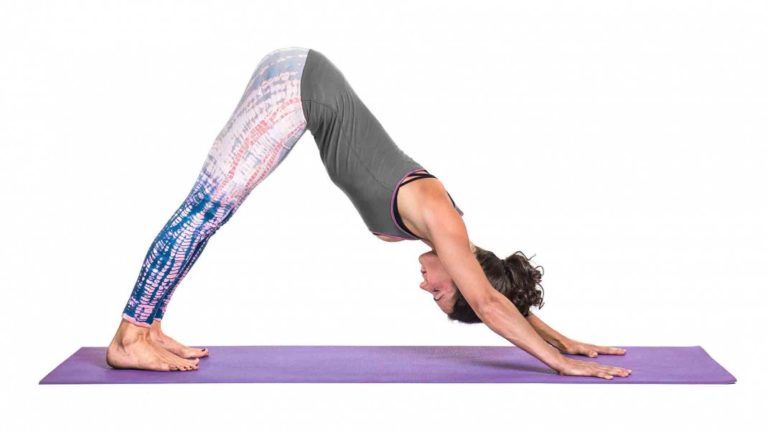Adho Mukha Svanasana: Downward-Facing Dog Pose

Adho mukha svanasana (AH-doh MOO-kah shvah-NAHS-anna), also known as downward-facing dog pose, is a mild inversion that calms the nervous system and helps relieve stress. During downward-dog, focus on the details of your inhale and exhale to hone your attention. Notice your breath before entering the pose, during the pose, and after leaving the pose.
Sanskrit:
- Adho = downward
- Mukha = face
- Svana = dog
- Asana = pose
Philosophy & Origin:
Adho mukha svanasana is practiced as a free-standing posture or as part of a vinyasa sequence and is used as a “resting” point for stretching the back of the legs and the shoulders.
Tips:
This pose stretches the hamstrings, calves, spine, and muscles in the back. Go slowly and listen to your body’s limits.
Physical Benefits:
- Stretches your hamstrings, calves, feet, and hands.
- Strengthens your arms, shoulders, and back.
- Improves mobility in your digestive system.
- Relieves back pain, headaches, insomnia, and fatigue.
Energetic Benefits:
- Elongates and releases tension from your spine.
- Helps relieve the symptoms of menopause.
Mudra: Apana Mudra
This mudra is also known as the “prayer mudra.”
How to: The tips of the middle and ring finger touch the tip of the thumb. The forefinger and little finger are stretched out and straight.
Benefits:
- Helps move prana energy to the periphery of the body.
- Regulates the excretory system and helps maintain internal chemical homeostasis.
- Aids in waste elimination from the mouth, eyes, ears, nose, throat, etc.
- Regulates diabetes.
- Helps with constipation and urine obstruction.
Mantra:
Om Mani Padme Hum Mantra
As translated by the Dalai Lama, this mantra means “the jewel is in the lotus,” or “praise to the jewel in the lotus.” Many contend that the true meaning of this mantra cannot be translated into a simple phrase or sentence, but all of the teachings reiterate that suffering in life is unnecessary, and through peaceful reflection and calculated action, we can avoid the aspects of our lives that cause suffering and embrace those that bring joy and enhance our daily lives. The lotus is often believed to be symbolic of our ability to rise out of darkness and blossom with beauty, and this recognition of how we rise out of dark conditions is invoked through the power of this mantra.
Preparatory Poses:
- Plank pose | Phalakasana
- Standing forward bend | Uttanasana
Follow-Up Poses:
- Standing forward bend | Uttanasana
- Mountain pose | Tadasana
- Sirsasana | Headstand
Contraindications and Cautions:
Before trying any inversion, check with a doctor before performing the pose if you have any of the following conditions:
- Wrist problems like carpal tunnel syndrome or arthritis
- High blood pressure
- Eye or inner ear infection
- Late-term pregnancy
Adjustments/Modifications:
- Ease pressure on your wrists by placing a wedge under your palms or performing the pose on your forearms (dolphin pose).
- Elevate your hands on blocks or on the seat of a chair to take weight off of your hands, wrists, and shoulders.
- Place your palms on a wall and walk your feet back for a standing variation of downward-facing dog with more control.
Step-By-Step:
- Start on your hands and knees in a table top position with your hands and knees shoulder width apart. Your hands should be slightly in front of your shoulders. Spread your fingers wide on your mat with your middle fingers facing forward. Firmly press your palms flat on your mat.
- Curl your toes under. Exhale slowly as you lift your knees off of the floor and send your hips skyward. Press your chest back toward your thighs.
- Move toward straightening your legs and lowering your heels, but don’t lock out your knees or try to force it.
- Tilt your sitting bones up high and rotate your inner thighs slightly in and up, aware of your low ribs’ tendency to jut out as you find length here. Draw the ribs gently back in by toning your belly.
- Press the pads of your fingers and your full palm into the floor. Straighten but don’t lock out your arms. Engage your upper arm muscles to draw your elbows slightly in and pull your shoulders out of your ears.
- Keep your neck neutral (ears aligned with biceps) with your your gaze looking slightly back toward your feet.
###Legal Disclaimer Before participating in any exercise program or using any fitness products or services that may be described and/or made accessible in or through the Gaia Website and/or the Services, you should consult with a physician or other healthcare provider. Read more about Gaia’s Terms Of Use.
Ardha Hanumanasana: Half Front Splits Pose

ADJUSTMENTS | BENEFITS | SEQUENCING | SANSKRIT | STEPS
Ardha hanumanasana (are-dah hah-new-mahn-AHS-ah-nah) is a big stretch for hamstrings. This pose is more approachable than full hanumanasana and strengthens the muscles needed to practice front splits safely with the correct muscles properly engaged.
Philosophy + Origin
One of the main characters of the Ramayana is Hanuman, the famous monkey god, devotee of Lord Rama, and son of Vayu (the god of wind). He is celebrated in the pose hanumanasana, which physically represents his famous “leap of faith,” taking him across the ocean from India to Sri Lanka. Ardha hanumanasana, the preparatory pose for hanumanasana, can represent the stability and strength needed to make grand, world-changing (or life-changing) gestures. Rather than only focusing on gaining flexibility, practice ardha hanumanasana to create a healthy balance of flexibility and strength. When practicing ardha hanumanasana, remind yourself of the dangers of only being flexible in life; in order to really get where you want to go, you must also be strong and stable.




































